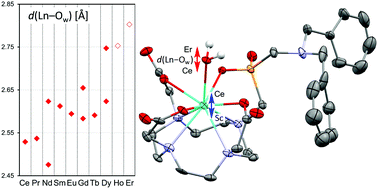The solid-state structures and ligand cavity evaluation of lanthanide(iii) complexes of a DOTA analogue with a (dibenzylamino)methylphosphinate pendant arm†
Abstract
A series of lanthanide(III) complexes of a monophosphinate analogue of H4dota, 1,4,7,10-tetraazacyclododecane-1,4,7-triacetic-10-methyl[(N,N-dibenzylamino)methyl]phosphinic acid (H4do3apDBAm = H4L1), were prepared and their solid-state structures were studied using single-crystal X-ray diffraction. In all structures, the ligand anion was octadentately coordinated to the Ln(III) or Sc(III) ions similarly to other DOTA-like ligands, i.e. forming parallel N4- and O4-planes. The lighter lanthanide(III) complexes (till dysprosium) were nonacoordinated in the twisted square-antiprismatic (TSA) configuration with the apical coordination of water molecules or oxygen atoms from the neighbouring complex unit. The heavier lanthanide(III) complexes (from terbium) were found as the “anhydrous” octacoordinated twisted square-antiprismatic (TSA′) isomer. For the terbium(III) ion, both forms were structurally characterized. The structural data of the Ln(III)–H4L1 complexes and complexes of several related DOTA-like ligands were analysed. It clearly showed that the structural parameters for the square-antiprismatic (SA) isomers were clustered in a small range while those for the TSA/TSA′ isomers were significantly more spread. The analysis also gave useful information about the influence of various pendant arms on the structure of the complexes of the DOTA-like ligands. The twist angle (torsion) of the chelate ring containing a larger phosphorus atom was similar to those of the remaining three acetate pendants. It led to a larger separation of the N4⋯O4 planes and to smaller trans-O–Ln–O angles than the parameters found in the complexes of H4dota and its tetraamide derivatives dotam(R). It resulted in a relatively long bond between the metal ion and the coordinated water molecule. It led, together with the negative charge of the oxygen atoms forming the O4-plane, to an extremely fast water exchange rate reported for the Gd(III)–H4L1 complex and, generally, to a fast water exchange of Gd(III) complexes with the monophosphorus acid analogues of H4dota, H5do3ap/H4do3apR.



 Please wait while we load your content...
Please wait while we load your content...